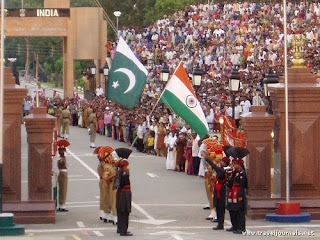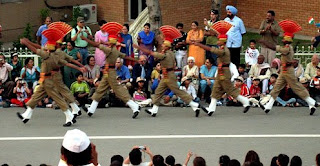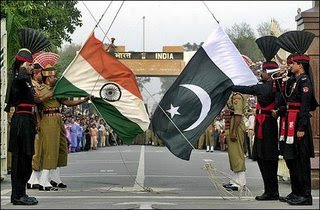
What was once just one portion of the thousands of kilometers long border that India and Pakistan share has over the years evolved into a place almost of pilgrimage…….for both nations. I am not sure whether the name Wagah comes from some village or bit of land on ‘our’ side or ‘their’ side but there it sits right bang on the Grand Trunk Road,in the middle of the fertile Punjab fields that are planted with the same crops by farmers of both sides at the same time, creating a seamless green carpet.
I first visited this border post in early 1972 as a child. The war had ended just a few months earlier and my dad was working at a place just about 25 kilometers from the Indo-Pak border in a small place called Khasa.
 These were days when the signs of the just concluded war were everywhere: from the bunkers in our front and backyards to the pieces of exploded bombs that we used to collect as souvenirs. The memories of those many spy dramas that we enacted with our friends in those very real bunkers will forever be amongst my fondest memories. Next year we were also to witness the return of Pakistani prisoners of war. We stood for hours peering through the coils of barbed wires as the prisoners in newly issued shorts, vests and sneakers collected near the Khasa station to await their turn to be sent back to their country.
These were days when the signs of the just concluded war were everywhere: from the bunkers in our front and backyards to the pieces of exploded bombs that we used to collect as souvenirs. The memories of those many spy dramas that we enacted with our friends in those very real bunkers will forever be amongst my fondest memories. Next year we were also to witness the return of Pakistani prisoners of war. We stood for hours peering through the coils of barbed wires as the prisoners in newly issued shorts, vests and sneakers collected near the Khasa station to await their turn to be sent back to their country.
 These were days when the signs of the just concluded war were everywhere: from the bunkers in our front and backyards to the pieces of exploded bombs that we used to collect as souvenirs. The memories of those many spy dramas that we enacted with our friends in those very real bunkers will forever be amongst my fondest memories. Next year we were also to witness the return of Pakistani prisoners of war. We stood for hours peering through the coils of barbed wires as the prisoners in newly issued shorts, vests and sneakers collected near the Khasa station to await their turn to be sent back to their country.
These were days when the signs of the just concluded war were everywhere: from the bunkers in our front and backyards to the pieces of exploded bombs that we used to collect as souvenirs. The memories of those many spy dramas that we enacted with our friends in those very real bunkers will forever be amongst my fondest memories. Next year we were also to witness the return of Pakistani prisoners of war. We stood for hours peering through the coils of barbed wires as the prisoners in newly issued shorts, vests and sneakers collected near the Khasa station to await their turn to be sent back to their country.Getting back to the border, we were shown around the border post by a Sikh officer of the Border Security Force. It was evening time and the sun was about to set. The lowering of the flag was about to take place and the Indian soldiers blew the bugle, marched to the gate and in a flurry of dramatic steps and salutes lowered the tri-color. The Pakistani soldiers came next but minus the fanfare and took their flag away quietly. We were told by the officer that because Pakistan had surrendered to the Indian forces, as per international convention, only India was allowed to lower the flag each evening ceremoniously. I do not remember how long this state of affairs lasted because on all subsequent visits I saw the two sides lowering their flags in the same manner with equal fan fare.
The Wagah border, back then, was just a couple of gates with the no-man’s land in between. On either side of the gates there was barbed wire for some 500 meters and then just plain fields looking on both sides. That these were two (often hostile) countries face to face across an international border was brought home only by the small stone markers with some numbers written on them.
The farmers on both sides continued their informal friendships and carried on their barely concealed small scale exchange/smuggling of some goods like betel leaves and onions etc There calm atmosphere made one almost forget that guns and bombs had created a cacophony there just months ago.
Wagah continued to exist in near anonymity, not known to many outside the army and BSF personnel and the people of the state. On subsequent visits in the seventies I saw Wagah become a more relaxed place and in the evenings the people of both Lahore and Amritsar would throng to it to watch the flag ceremony and to gape at and occasionally wave to each other. In those days the people were allowed to come right up to the gates once they were shut and people would shout out greetings to each other in a language they both share. While the women dressed the same way on both sides the men on the Pakistani side mostly dressed in the Shalwar Kameez that was labeled “Awami suit” during the rule of Zia-ul-Haq and was made almost compulsory.
Now, 21 years later I visited the Wagah again and that too on the Independence Day, this year. It would be an understatement to say that things have changed. What was once a laid back border post is now a tourist destination that attracts hundreds of visitors each day. A virtual cottage industry has sprung up around the growing ‘fame ‘of Wagah. The evenings have the atmosphere of a village ‘mela’ with everything from ‘aaloo tikki’ to popcorn being sold from make shift stalls. There are stalls selling the usual touristy items like T-shirts, caps, key chains and pictures of the Wagah border post.Al this is haphazard development with very little attention paid to the issues of public facilties like parking.


All this is about 250 yards away from the actual border but the proverbial Indian entrepreneurial skill can be seen even at the new visitor’s galleries that have been built some 50 yards from the main gates. Small boys, some as young as just 8 can be seen moving briskly amongst the visitor’s selling pictures and CDs of the flag ceremony. What the gullible visitor pays Rs.100 for during the ceremony can be bought for just Rs.10-15 later further away from the gates. Needless to say that I was in the gullible category
These changes were a surprise for me because I have seen the Wagah in its earlier peaceful avatar. But the bigger shock for me was the manner in which the Retreat ceremony itself has changed over the years into a virtual war dance of confrontation. In what are obviously well choreographed moves the soldiers, on both sides, march right up to the gate to face each other. Then the BSF personnel make some very distinct hand and feet movements that leave no doubt in the mind that this is saber rattling of another kind.The same is then done by the Pakistani Rangers.
Each side tries to out do the other in the ferocity of their steps and salutes and I am told that each side now has men that specialize in the whole sequence. They try to bring their own unique style to the ceremony and the whole thing is now nothing short of a spectator sport. In earlier days the Indian soldiers would be towered over by the taller and sturdier Pakistani rangers but now India is up to speed and posts mostly exceptionally tall men here. I must confess however that the Pakistanis are still outdoing our men in the moustache department!
Because it was the Independence Day (the Pakistanis had celebrated theirs on the previous day, August 14) special arrangements had been made to have entertainment programs that ranged from a band singing patriotic songs (from what else but Bollywood films) to troops of school children dancing and waving the Indian flag. Occasionally they would move in groups towards the gate in an excited rush and raise the slogan Bharat Mata Ki Jai. This of course is then matched by similar groups shouting Pakistan Paiendabad from the other side. The whole point of the evening was to drown each others din by ratcheting up the volume on your side. This was filmy patriotism but with a barely concealed undercurrent of hostility. Men on microphones exhort the crowds to a fevered frenzy by asking them to clap in rhythm and make sure the Pakistani slogans are drowned out by our own. The same happens on the other side.
Both sides tried their best but the Indians being masters of mass Bollywood style entertainment were certainly leagues ahead, at least on this evening. The Pakistani side was more muted with very few women in the stands. The school girls that danced on the Indian side with total abandon had their counterparts on the other side in school girls wearing head scarves and waving flags demurely.
The irony of the division of British India into two countries is driven home when the Indian side proudly plays the song, “sarey jahan se achha, Hindustan hamara” penned by the poet Iqbal(1877-1938) who was later to be known as the national poet of Pakistan. The Indian side followed it up by playing a song from the film Naya Daur that sings of India as the land of brave soldiers, pretty Heers and handsome Ranjhas. Technically these legendary lovers were from the Punjab that is with Pakistan now and the tale of their tragic love was celebrated by the poet Waris Shah ,born in1722-98 in Jandiala Sher Khan, District Sheikhupura, Punjab (Pakistan), in his famous poem Heer.
Mingling with the teeming crowds were tourists of many western countries who joined in the carnival like atmosphere but commented that they knew of no other border between hostile neighbours that could boast of such colourful and musical drama.
Although I was spell bound by the whole show that the soldiers put up I could not help wondering at the aim behind encouraging such strong emotions against each other at a border post. There has been enough enmity for 61 years and if the scale of that has to be lowered then surely this is not the way to do it.
I later found out that the whole show that goes with such precision and co ordination is the result of the soldiers of both sides working out the whole routine together. I found it amusing that the soldiers who put on this modern day version of a war dance actually work together behind the scene to ensure that the whole thing goes about without a move out of place. Similar shows on a lesser scale can now be seen on the Ferozepur border also.
Sitting in the VIP gallery just 100 yards away from the Pakistani crowds I could not help but wonder about all those places that my family members of the previous generation left behind to make their way to safety on this side in 1947.None believed at the time that they would not be going back and all clung to their memories and stories till the end of their lives. I wondered if, sitting in the crowds on the other side, someone else was wondering the same about his/her relatives who had trudged across to the Pakistani side in that tragic year. I wondered, too, about this whole notion of identity. What makes up identity? Does it come from a shared religion or a shared language or from the shared cultural experiences, stories, songs and collective memories of a people? Or is it defined by borders and boundries?
When there was a lull in the music I could hear the Pakistanis singing their song, ‘Jeevay, jeevay, jeevay Pakistan’ and the memories of hours of watching Pakistani television in childhood came back and unknowingly I started humming along till I was politely reminded by my brother that I could possibly be lynched by the crowds for sitting on this side and singing a song wishing Pakistan a long life. The irony of it all brought sobriety back and I joined the crowds in singing lustily, “mere desh ki dharti sona uglay, uglay heeray moti.”
P.S: As I got up to leave the stands I could not help noticing that, probably in an assertion of their Arabic (real or imagined) roots, the Pakistani side has named the grand stand on their side Bab – Azadi (Arabic for gateway of freedom) rather than Azadi Darwaza in Urdu. That has been the struggle for Pakistan: to find an identity for itself, distinct from it’s larger and more diverse neighbour. In this effort many there live in the belief that their history starts in the 8th century with the invasion of Sindh by Mohammed Qasim and not 5000 earlier with the Indus valley civilisation, not with the blooming of Buddhism or the ethos of Hinduism.
While the Indian side was festooned with lights and flags for the Independence Day, atop the Bab-Azadi, on Pakistani side, was a crude model of the Pakistani missile (Ghazni or Ghouri, I think). It seemed so out of place atop the graceful gate way made in the Mughal style. The events of the months since my visit make it seem even more misplaced. With the threat to Pakistan emerging from its northern borders(Taliban and Al-Qaeda) and from home grown Islamic radicalism, I wonder if they would be placing that silly model of the missile atop the gate again next year.






No comments:
Post a Comment